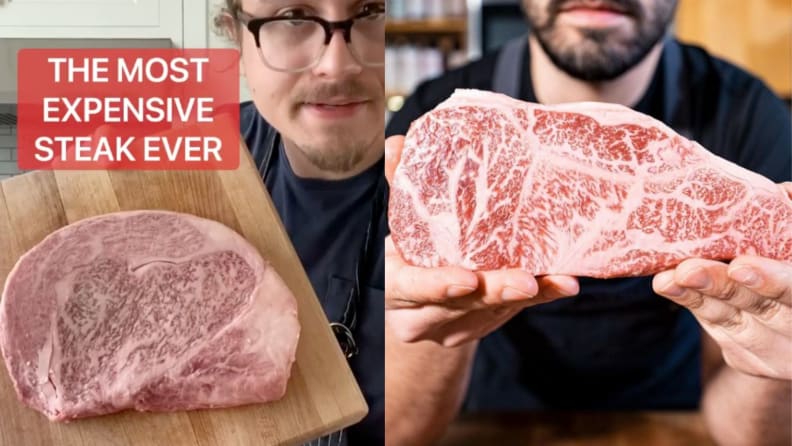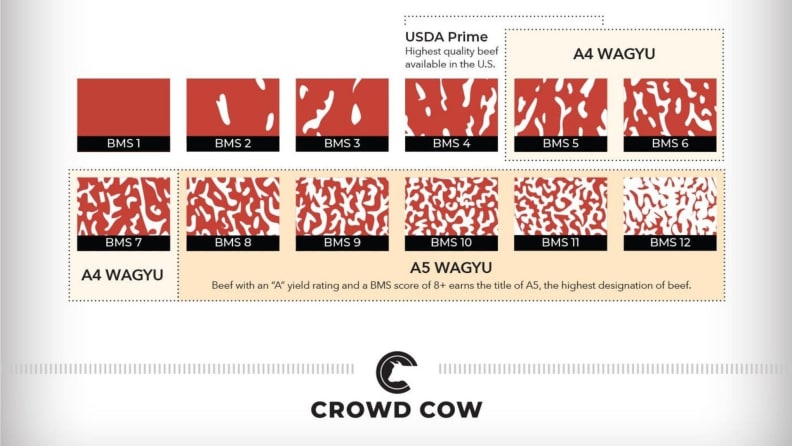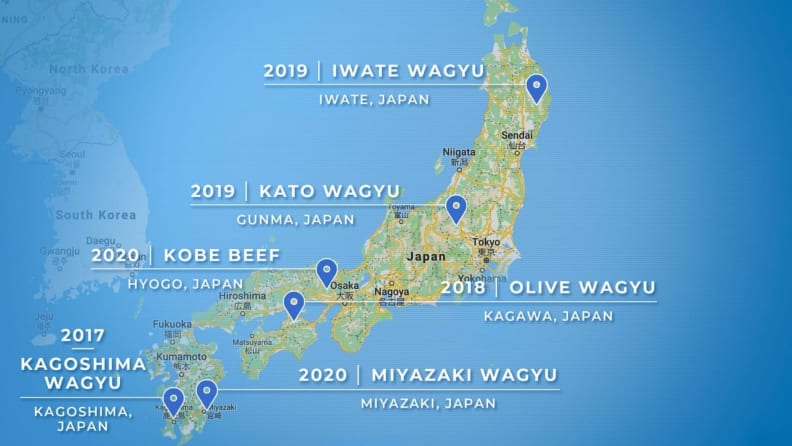Everything you need to know about wagyu beef
We chatted with the experts to get the lowdown on all things wagyu.
Products are chosen independently by our editors. Purchases made through our links may earn us a commission.
For years, celebrity chefs and home cooks alike have utilized social media to show off their skills and capture standout meals. And if you’ve ever gone down the rabbit hole of popular food Instagram pages or hashtags, you’ve probably fallen victim to the clickbait of trendy foods such as over-the-top gold flaked doughnuts, burritos stuffed with macaroni and hot cheetos, or decadent burnt cheesecake.
A majority of such trends can be called “stunt foods,” meaning food that will look pretty on camera and get a lot of likes, but might not taste great. However, in recent months, chefs on Instagram and the popular video-sharing app TikTok have been showing lots of love to wagyu beef, specifically the most expensive variety, Japanese A5 Wagyu.
What is wagyu beef?
Wagyu literally translates in English to “Japanese cow” and is regarded as some of the highest quality beef in the world. Although wagyu is a new concept to many Americans, it has a long history—some even argue the genetic strain traces back over 35,000 years! In 1997, Japanese officials enacted an export ban, citing that wagyu cattle had become a “national treasure,” in order to keep its authenticity exclusive to Japan. However, wagyu beef had already picked up interest in America, and restrictions have since been carefully loosened.
Many wagyu cattle farmers are multigenerational and take great pride in their craftsmanship. The beef is characterized by its intricate marbling, or distribution of soft whie intramuscular fats within the red meat. This renders down when seared, resulting in a unique, meltaway texture.
Who cooks wagyu beef?

In the past year, wagyu beef has been popularized by users on apps like TikTok and Instagram.
In a TikTok video from popular YouTube chef Joshua Weisman titled “The Most Expensive Steak Ever,” Weisman cooks a wagyu filet. Weisman goes on to explain the significance of the ingredient and quickly runs through how to cook it, and ends the video by cutting it on a diagonal and making sure to reiterate that this is one of the “most expensive steaks on the planet.”
Weisman isn’t the only popular chef on social media capitalizing on wagyu beef. In similar videos, Spiceology chef Matt Broussard shows off cuts of wagyu beef and walks the viewer through the cooking process, taking time to explain what makes it so special.
Additional popular social media users posting about wagyu include “That Dude Can Cook” and “Sam the Cooking Guy,” among others.
How much does wagyu cost and why is it so expensive?

Wagyu beef is known for its marbling, as illustrated here.
Japanese A5 Wagyu is characterized by intricate marbling and unbelievably melt-in-your-mouth texture. Weisman’s TikTok has over four million views and over a million likes, and it’s just one of several examples of chefs utilizing the wagyu’s price tag as a way to attract virality.
While chefs like Weisman aren’t wrong about the price tag—a quality cut of Japanese A5 Wagyu often costs between $200 to $400—the ingredient’s rich history extends far beyond a flash-in-the-pan trend. Not only that, but importers of wagyu such as Crowd Cow have gone to great lengths to honor the ingredient while providing the rare opportunity for home chefs to experience its magic from the comfort of their own kitchens.
“We are the number one seller of Japanese beef,” says Crowd Cow co-founder and CEO Joe Heitzeberg. In fact, Crowd Cow was America’s first-ever direct sourcer-seller of A5 wagyu from Japan.
Of the four wagyu breeds, the Kuroge Washu cattle from Miyazaki are particularly world renowned due to the province's climate. Surrounded by mountains, these cattle graze on vegetation grown in fertile, organic volcanic soil.
Miyazaki was one of the first provinces to export wagyu to the United States, and the beef was soon adored for its incredible quality and balance. According to Heitzeberg, the cattle’s metabolization of the vitamins and minerals packed in the vegetation is what gives the beef its characteristic marbling.
“The genetic ability of wagyu [cattle] is some of the most unique in the world,” says Heitzeberg. “Against most other luxurious foods, [wagyu beef] is way more accessible to the American palette versus other ingredients such as foie gras and truffles. One piece of this beef is mind blowing and excellent, and I think most Americans would be open to the experience.”
What’s the difference between wagyu and kobe beef?
If you haven’t come across wagyu yet in your dining experience, it’s more likely that you’ve seen “kobe” featured on an American restaurant menu, oftentimes in the form of a burger (looking at you, Cheesecake Factory).
Kobe is one of several varieties of wagyu—personally, I like to think of it using the mantra, “all kobe steak is wagyu, but not all wagyu beef is kobe.” To be labeled kobe, cattle must be born, raised, and slaughtered within the Hyogo Prefecture and meet several technical requirements.
That’s why, according to multiple investigations and Heitzeberg himself, just because something is labeled on a menu as kobe does not mean it’s the real deal.
Building relationships abroad

Surrounded by mountains, the wagyu cattle in Miyazaki, Japan graze on vegetation grown in fertile, organic volcanic soil.
It took Heitzeberg years to build direct relationships with his wagyu distributors. His journey began as a college study on a farm homestay in rural Japan, where he was offered to try wagyu when celebrating his 20th birthday. As soon as he tried the delicacy, he was hooked. Two decades later, Crowd Cow was born.
Per Heitzeberg, what set his company apart was his promise to Japanese producers and local governments that Crowd Cow would treat A5 wagyu with respect. It wouldn’t be just a source for purchasing the beef—it would be an educational experience for all Americans.
Since 2017, Crowd Cow has developed relationships with six different Japanese breeders across the country. Thirteen varieties of wagyu are offered from Kagoshima Farms, as well as eight varieties of A5 Miyazakigyu Wagyu from Japan’s Miyazaki prefecture, which is recognized as producing some of the top-ranked wagyu in all of Japan.
What’s it like to order wagyu beef online?
When you order from Crowd Cow, not only is the beef is delivered in a carefully crafted, dry-ice sealed package in order to ensure freshness, you also receive plenty of reading materials that explain the ingredient’s history, in addition to detailed instructions on how to defrost, rest, season and cook.
“You absolutely want to thaw it to room temperature, then dial a cast iron or stainless steel pan to high heat,” said Heitzeberg. “The fat in the wagyu will immediately render down, so no need to oil the pan. One minute per side, then sprinkle sea salt or give it a quick dip in soy sauce, and enjoy.”
I won’t lie, when my Crowd Cow order arrived at my apartment, it was hard not to be intimidated. I was sent a one pound cut of their A5 wagyu ribeye, which I uncovered after unfortunately naively burning my hands on the dry ice. (Now I know—use gloves next time!)
As I let the wagyu thaw, I couldn’t help but think: What if I messed up, and somehow ruined such a precious ingredient? I took a deep breath, reminded myself of Heitzeberg’s advice, and focused on preparation. I made sure to slice the wagyu into one inch slices, seared it in an unoiled pan, and topped it off with some flaky sea salt. The finished product was one of the most memorable meals I had ever cooked in my tiny kitchen.
As soon as I took my first bite, Crowd Cow’s Japanese A5 Wagyu completely melted into a flavor bomb of extraordinary rich umami. Just a few pieces were all I needed to feel completely satisfied. I walked away feeling as if I had experienced something truly special.
Is wagyu beef worth it?
Whether you’re looking to make the next viral TikTok video or simply want to experience a restaurant-quality meal, wagyu beef is a high-quality cut of meat that will absolutely hit the mark and then some. For a convenient option, try ordering wagyu online from somewhere like Crowd Cow. Or, stop by your local grocery store and ask the butcher about their recommendations for the best wagyu cut for your particular dish.


